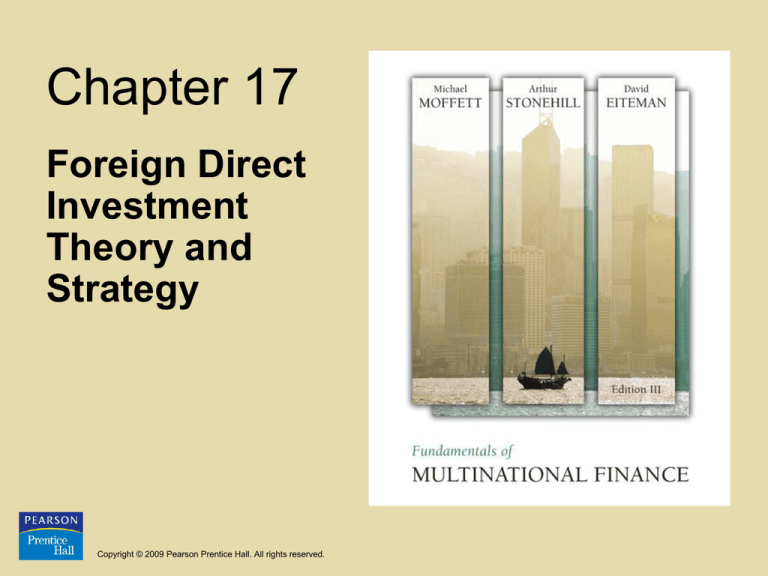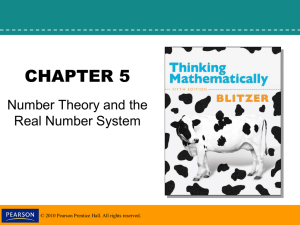
Chapter 17
Foreign Direct
Investment
Theory and
Strategy
Copyright © 2009 Pearson Prentice Hall. All rights reserved.
Foreign Direct Investment
Theory & Strategy: Learning Objectives
• Demonstrate how key competitive advantages support
MNEs’ strategy to originate and sustain foreign direct
investment
• Show how the OLI paradigm provides a theoretical
foundation for the globalization process
• Identify factors and forces that must be considered in
the determination of where MNEs’ invest
Copyright © 2009 Pearson Prentice Hall. All rights reserved.
17-2
Foreign Direct Investment
Theory & Strategy: Learning Objectives
• Illustrate the managerial and competitive
dimensions of the alternative methods for
foreign investment
• Identify the strategies used by MNEs originating
in developing countries to compete in global
markets
Copyright © 2009 Pearson Prentice Hall. All rights reserved.
17-3
Market Imperfections:
A Rationale for the MNE
• MNEs strive to take advantage of imperfections
in national markets
• These imperfections for products translate into
market opportunities such as economies of scale,
managerial or technological expertise, financial
strength and product differentiation
Copyright © 2009 Pearson Prentice Hall. All rights reserved.
17-4
Sustaining & Transferring
Competitive Advantage
• In deciding whether to invest abroad, management must
first determine whether the firm has a sustainable
competitive advantage that enables it to compete
effectively in the home market
• In order to sustain a competitive advantage it must be:
– Firm-specific
– Transferable
– Powerful enough to compensate the firm for the extra
difficulties of operating abroad
Copyright © 2009 Pearson Prentice Hall. All rights reserved.
17-5
Sustaining & Transferring
Competitive Advantage
• Some of the competitive advantages enjoyed by
MNEs are:
–
–
–
–
–
–
Economies of scale and scope
Managerial and marketing expertise
Advanced technology
Financial strength
Differentiated products
Competitiveness of the their home market
Copyright © 2009 Pearson Prentice Hall. All rights reserved.
17-6
Exhibit 17.1
Determinants of National Competitive
Advantage: Porter’s Diamond
Copyright © 2009 Pearson Prentice Hall. All rights reserved.
17-7
The OLI Paradigm &
Internationalization
• The OLI Paradigm (Buckley & Casson, 1976; Dunning
1977) is an attempt to create an overall framework to
explain why MNEs choose FDI rather than serve
foreign markets through alternative modes such as
licensing, joint ventures, strategic alliances,
management contracts and exporting
• The paradigm states that a firm must first have some
competitive advantage in its home market - “O” or
owner-specific – which can be transferred abroad
Copyright © 2009 Pearson Prentice Hall. All rights reserved.
17-8
The OLI Paradigm & Internalization
• The firm must also be attracted by specific
characteristics of the foreign market – “L” or location
specific – which will allow the firm to exploit its
competitive advantages in that market
• Third,the firm will maintain its competitive position by
attempting to control the entire value-chain in its
industry – “I” or internalization
• This leads to FDI rather than licensing or outsourcing
Copyright © 2009 Pearson Prentice Hall. All rights reserved.
17-9
The OLI Paradigm & Internalization
• Financial strategies are directly related to the
OLI Paradigm in explaining FDI
• Strategies can be proactive , controlled in
advance by the management team
• Strategies can also be reactive, depend on
discovering market imperfections
Copyright © 2009 Pearson Prentice Hall. All rights reserved.
17-10
Exhibit 17.2 Finance-Specific Factors and
the OLI Paradigm: “X” indicates a connection
between FDI and finance-specific strategies
Copyright © 2009 Pearson Prentice Hall. All rights reserved.
17-11
Where to Invest
• Two related behavioral theories behind FDI that are
most popular are
– Behavioral approach to FDI
– International network theory
• Behavioral Approach – Observation that firms tended
to invest first in countries that were not too far from
their country in psychic terms
– This included cultural, legal, and institutional environments
similar to their own
Copyright © 2009 Pearson Prentice Hall. All rights reserved.
17-12
Where to Invest
• International network theory – As MNEs grow they
eventually become a network, or nodes that operate
either in a centralized hierarchy or a decentralized one
– Each subsidiary competes for funds from the parent
– It is also a member of an international network based on its
industry
– The firm becomes a transnational firm, one that is owned by a
coalition of investors located in different countries
Copyright © 2009 Pearson Prentice Hall. All rights reserved.
17-13
How to Invest Abroad: Modes
of FDI
• Exporting vs. production abroad
– Advantages of exporting are
• None of the unique risks facing FDI, joint ventures,
strategic alliances and licensing
• Political risks are minimal
• Agency costs and evaluating foreign units are avoided
– Disadvantages are
• Firm is not able to internalize and exploit its
advantages
• Risks losing market to imitators and global
competitors
Copyright © 2009 Pearson Prentice Hall. All rights reserved.
17-14
How to Invest Abroad: Modes
of FDI
• Licensing/management contracts versus control of
assets abroad
– Licensing is a popular method for domestic firms to profit
from foreign markets without the need to commit sizable
funds
– Disadvantages of licensing are
• License fees are likely lower than FDI profits although ROI may be
higher
• Possible loss of quality control
• Establishment of potential competitor
• Possible improvement of technology by local license which then
enters firm’s original home market
Copyright © 2009 Pearson Prentice Hall. All rights reserved.
17-15
How to Invest Abroad: Modes
of FDI
• Possible loss of opportunity to enter licensee’s market with FDI later
• Risk that technology will be stolen
• High agency costs
– Management contracts are similar to licensing insofar as they
provide for some cash flow from foreign source without
significant investment or exposure
– These contracts lessen political risk because the repatriation
of managers is easy
Copyright © 2009 Pearson Prentice Hall. All rights reserved.
17-16
How to Invest Abroad: Modes
of FDI
• Joint ventures versus wholly owned subsidiary
– A joint venture is a shared ownership in a foreign business
– This is a viable strategy if the MNE finds the right local
partner
– Some advantages include
• The local partner understands the market
• The local partner can provide competent management at all levels
• Some host countries require that foreign firms share ownership with
local partner
Copyright © 2009 Pearson Prentice Hall. All rights reserved.
17-17
How to Invest Abroad: Modes
of FDI
• Joint ventures versus wholly owned subsidiary
– Advantages of joint ventures
• The local partner’s contacts & reputation enhance access
to host country’s capital markets
• The local partner may possess technology that is
appropriate for the local environment
• The public image of a firm that is partially locally owned
may improve its position
Copyright © 2009 Pearson Prentice Hall. All rights reserved.
17-18
How to Invest Abroad: Modes
of FDI
• Joint ventures versus wholly owned subsidiary
– Disadvantages of joint ventures
• Political risk is increased if wrong partner is chosen
• Local and foreign partners have divergent views on strategy and
financing issues
• Transfer pricing creates potential for conflict of interest
• Financial disclosure between local partner and firm
• Ability of a firm to rationalize production on a worldwide basis if that
would put local partner at disadvantage
• Valuation of equity shares is difficult
Copyright © 2009 Pearson Prentice Hall. All rights reserved.
17-19
How to Invest Abroad: Modes
of FDI
• Greenfield investment versus acquisition
– A greenfield investment is establishing a facility “starting
from the ground up”
• Usually require extended periods of physical construction and
organizational development
– Here, a cross-border acquisition may be better because the
physical assets already exist, shorter time frame and financing
exposure
• However, problems with integration, paying too much for acquisition,
post-merger management, and realization of synergies all exist
Copyright © 2009 Pearson Prentice Hall. All rights reserved.
17-20
How to Invest Abroad: Modes
of FDI
• Strategic alliances can take several different forms
– First is an exchange of ownership between
two firms
– It can be a defensive strategy against a takeover
– In addition to exchanging shares, a separate joint venture can
be developed
– Another level of cooperation may be a joint marketing or
servicing agreement
Copyright © 2009 Pearson Prentice Hall. All rights reserved.
17-21
Exhibit 17.3 The FDI Sequence: Foreign
Presence and Foreign Investment
Copyright © 2009 Pearson Prentice Hall. All rights reserved.
17-22
Strategies Employed by Emerging
Market MNEs
•
•
•
•
•
•
Taking brands global
Engineering to innovation
Leverage natural resources
Export successful business model
Acquire offshore assets
Target a market niche
Copyright © 2009 Pearson Prentice Hall. All rights reserved.
17-23
Exhibit 17.4 Emerging Market
Multinationals and Their Global Strategies
Copyright © 2009 Pearson Prentice Hall. All rights reserved.
17-24
Summary of Learning Objectives
• In order to invest abroad a firm must have a sustainable
competitive advantage in the home market. This must
be strong enough and transferable to overcome the
disadvantages of operating abroad
• Competitive advantages stem from economies of scale
and scope, managerial and marketing expertise,
differentiated products, and competitiveness of the
home market
• The OLI Paradigm is attempt to create an overall
framework to explain why MNEs choose FDI rather
than serve foreign markets through other methods
Copyright © 2009 Pearson Prentice Hall. All rights reserved.
17-25
Summary of Learning Objectives
• Finance-specific strategies are directly related to
the OLI Paradigm, including both proactive and
reactive strategies
• The decision about where to invest is influenced
by economic and behavioral factors
• Psychic distance plays a role in determining the
sequence of FDI
Copyright © 2009 Pearson Prentice Hall. All rights reserved.
17-26
Summary of Learning Objectives
• Most international firms can be viewed from a network
perspective. The parent firm and each of the
subsidiaries are members of the network
• Exporting avoids political risk but not foreign exchange
risk. It requires the least up-front investment but it
might eventually have lost those markets to competition
• Alternative modes of FDI exist, such as joint ventures,
strategic alliances, licensing, management contracts,
and traditional exporting
Copyright © 2009 Pearson Prentice Hall. All rights reserved.
17-27
Summary of Learning Objectives
• Licensing enables a firm to profit from foreign markets
without a major up-front investment,however
disadvantages include limited returns, possible loss of
quality control, and potential to establish future
competitor
• The success of a joint venture depends primarily on the
right partner. For this reason a number of issues related
to possible conflicts in decision making exist
Copyright © 2009 Pearson Prentice Hall. All rights reserved.
17-28
Summary of Learning Objectives
• Six major strategies used by emerging market MNEs
are:
–
–
–
–
–
–
Taking brands global
Engineering to innovation
Leverage natural resources
Export successful business model
Acquire offshore assets
Target a market niche
Copyright © 2009 Pearson Prentice Hall. All rights reserved.
17-29







